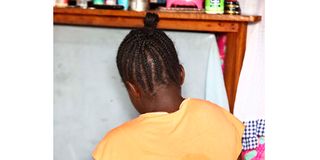We are the ARV generation
What you need to know:
- The advent of antiretroviral medication was a game-changer for many living with HIV and gave millions a lifeline.
- Thousands of children born with the virus have now come of age and are living through the motions of teenage.
For over a decade, Millicent Wakio didn’t know that she was HIV positive. She would later learn of her status from her caregiver at her hospital bed.
“Why am I taking drugs every day, I am tired, what is ailing me?” she asked the nurse.
On noticing that she was not informed, the nurse told her the only way to maintain a healthy life was by taking the drugs religiously. “Take the drugs and be strong,” the nurse said. But Millicent, who hails from Kisumu, didn’t understand what she was being told to be resilient for. She was aged 13 then.
Upon discharge, the nurse broke the news. “You’re HIV positive. But you need to live a life of optimism.”
Millicent was not only shocked, but angered too. She had to go through a number of counselling sessions to accept her status.
At the age of 16, when she was just doing well, and without informing anyone, she stopped using her drugs, citing stigma from her peers.
For three months, she did not take her drugs. At this point, the symptoms almost killed her. She was very sick and stayed in the hospital for a month.
Since then, she has been taking her drugs and says nothing will make her stop her drugs.
“I remember that I almost lost it, my mother coming to my hospital bed and crying. I will forever take my drugs,” Millicent tells Healthy Nation while holding a blue bottle of her drugs.
The 20-year-old has since been a motivator to adolescents who are struggling to take their drugs.
“Once you accept your status, then it is easy to take your drugs. Once you drop them, then it will not be long before your tribute is done,” she says.
For Mildred Atieno* from the Kibera Community Health Centre-Amref, where she gets her antiretroviral therapy (ARVS) medication, being HIV-positive is not something to be shameful about.

Mildred Atieno* 17, during the interview in Langata on November 24, 2022. She was born with HIV.
The Form Three student smiles when she sees us, and is not shy about telling us that she has been consistently taking her drugs even though that involves walking for many kilometres every month to get the lifesaving drugs.
“I feel great, there is no better feeling than knowing your viral load is very low and negligible because you have been constantly taking your drugs,” says Mildred.
The 17-year-old was born with the virus. The journey, she says, has not been easy.
“My parents did not disclose to me what I was dealing with early enough, they just used to give me medication and compel me to take it without explaining why and so at a point in my life all I knew was that my entire existence depended upon me religiously taking what I was being given,” she says.
She took a science class while in primary school for her to have an idea of what HIV/Aids was all about, and the importance of ARVs and that’s how she understood what she was going through.
“I have come to learn that it is only a predicament if you look at it as such but with a proper mindset and the drugs available to us coupled with a proper diet, things work out very well.”
Most Kenyan adolescents have had to live with the virus, with many of them appreciating where they have come from, thanks to the ARVs that have since given them a new lease on life.
Mildred tells Healthy Nation that she used to think HIV was a death sentence because in one of the textbooks in school, alongside the very important information they had given on HIV, there was a picture of a coffin. “My mother told me to ignore it and just focus on taking my medication and living positively and believe me or not I rarely fall sick, get a cold or even malaria.”
Counselling sessions have helped her given the fact that discrimination is still a big issue.
But taking medication during school hours is tricky and most of the time she has to hide in the toilet and use the taps in there because her peers will emotionally break her down with endless questions and shun her if they see her with ARVs.
“However, I have had to tell my doctors to change the time prescribed for me to take my pills because at school, the endless questions from my mates who want to know why I am always popping pills would just not stop plus the ‘toilet water’ is honestly disgusting and has very bad taste.”
Mildred adds that the support she gets from the Amref-run health centre has really changed her life for the better.
“They have sessions where all of us, mostly who were born with HIV, meet regularly and spend time together, we call ourselves champions and these meetings remind you that you are not alone , that someone out there who completely gets what you are going through is there to support and encourage.”
They look out for each other and try to ensure that each one is taking their medication.
And she has a message to those living with HIV/Aids: “I know there are many young people who after finding out that they are positive, still struggle to accept the situation for what it is. Well, it’s not written on anyone’s forehead that they are living with the virus, don’t think about death, think about life and the many things you are destined to accomplish because with ARVs everything is very manageable. Your self-esteem should never take a beating over this and if anyone discriminates against you go and report to the police.”
Mildred is of the view that those defaulting on ARVs largely do so because of peer pressure.
In their ‘champions group’, they take turns in sharing about the challenges they are going through and then suggest solutions. They have few cases of those who completely gave up but they take lessons from their journeys.
Without encouragement and guidance from the experts at Amref, many of the young people who are now doing very well would have given up “because peer pressure gets many off their medication.”
Mildred discloses that many youths who are living with HIV are dating and are sexually active.
“It is not easy to disclose your status to the person you are dating. You have to keenly observe and be sure that the person you are opening your life to will not lead the gang that will come to mock you,” says Collins Isichi who hails from Lang’ata, Nairobi and was also born with the virus.
“I didn’t know I was living with HIV/Aids until I was 14 but I had been taking ARVs. But one day my parents explained everything. Since then, I have been taking good care of myself and taking my medication.”
Collins, 18, appreciates his parents for being honest and straightforward because it helped him accept his situation. “I don’t mind living positively publicly. That is my own way to contribute to helping more young people living with the virus take their medication. There’s nothing to be ashamed of.”

Collins Isichi, 18, during the interview in Kibera, Nairobi on November 24, 2022. He was born with HIV.
The young man, like Mildred, discloses that thanks to ARVs, he rarely catches even a cold.
“I honestly don’t remember the last time I even had to deal with malaria, taking ARVs is very easy, you just get a hold of your pills as prescribed and put them in your mouth and chase with a glass of water while making sure you do it on time and the more you take your medication as instructed, the more your viral load goes down.”
Collins reveals that he is actively dating.
Forty years ago, HIV/AIDS was labelled the “slim disease” because those who tested positive lost weight dramatically. The scary and moralistic images of the 1900s still haunt many people’s view of HIV to date.
Skeletal human frames
This was carried on to the 2000s when people living with HIV were condemned, stigmatised and even called outcasts. People literally ran away from skeletal human frames.
There was no effective treatment available, those diagnosed with the disease faced debilitating illness and most of them had a few weeks and months from diagnosis to death.
As the world commemorates World AIDS Day on Thursday, it is a moment to reflect back and remind humanity that there is work to do to eradicate HIV.
The virus was first clinically observed in the United States in 1981 and with speed, in 1985, the first ARV clinical trials and first HIV test were approved and in two years, in 1987, the first ARV was approved for use.
Within 10 years, ARVs were being prescribed in various combinations. Thousands of people with HIV had started ,taking drugs, however, because of the cost, not everybody could afford the drugs, more so in middle-income countries.
In 2001, many big pharmaceuticals started the manufacturing of low-cost generic ARVs for sub–Saharan Africa.
This has since helped many Kenyans who live on drugs and are doing well. According to the data from the Ministry of Health, about 1.5 million Kenyans are HIV positive and one million of them are estimated to be receiving antiretroviral medicines.
Globally, according to World Health Organization estimates, 38.4 million people are living with HIV and about two-thirds of them, 25.6 million are in the WHO African region. Out of the number, only 28.7 million were accessing antiretroviral therapy; meaning about 9.7 million people are still waiting.
This year’s theme calls on countries to address inequalities and help end Aids by increasing the availability, quality and suitability of services, for HIV treatment, testing and prevention, so that everyone is well-served.
With an increase in access to effective HIV prevention, diagnosis, treatment and care, including for opportunistic infections, HIV infection has become a manageable chronic health condition, enabling people living with HIV to lead long and healthy lives.
However, the world will have to consider the adolescents who continue to be disproportionately affected by HIV in many countries.
About a third of new HIV infections are in people aged 15-25 years. In almost all countries where HIV affects many groups, young women aged 15–24 years are three to five times more likely than their male counterparts to have HIV.
In 2021, at least 98 new HIV cases occurred every week among adolescents aged 10-19 in Kenya. The new infection data shows that women and girls account for 63 per cent of people living with HIV.
New HIV infections are three times higher among adolescent girls and young women (aged 15 to 24 years) than among males of the same age.
Since 2010, the decline in new HIV infection has been much sharper among adolescent boys and young men (56 per cent) than among adolescent girls and young women (42 per cent) or older women (aged 25 to 49 years) (29 per cent).
Dr Patrick Oyaro, a HIV expert, says ARVs are important interventions in improving longevity and preventing opportunistic infections among people living with HIV and should be taken for a lifetime. Dr Oyaro asks the government to ensure the country does not experience shortage of antiretroviral drugs as millions of people depend on them to survive. “People taking the drugs can live a normal life and that’s why we always preach adherence,” Dr Oyaro says.
[email protected]




